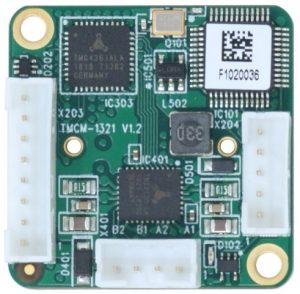
TMCM-1321, as it is known, controls two-phase bipolar stepper motors and includes a magnetic encoder and digital inputs for an optical encoder.
It is a 28 x 28mm module, although it needs more space than this because “it is recommended to connect an electrolytic capacitor of significant size – 470µF 35V for example – to the power supply lines next to the TMCM-1321”, according to the company.
The module is designed to be mounted across the back of a stepper motor that has a magnet attached to the rear of the shaft to operate its encoder. Feedback from this combined with movement instructions through an RS-485 interface allows the unit to move motor position from point to point, further controlled by a choice of linear ramping, the company’s own ‘SixPoint’ ramping or S-shaped ramping.
A feature branded StallGuard2 offers sensorless load measurement using the back EMF of the coils, and can be used for stall detection.
“When selecting an energy efficient drive, engineers tend to look at servo drives,” said Trinamic director Jonas Proeger. “However, stepper motors have a considerably higher torque than servo motors of comparable size at low speeds. This makes stepper motors well-suited to get rid of a gearbox without losing positioning accuracy when you combine them with closed-loop control. You get the efficiency of a servo motor at the cost of a stepper motor.”
It is designed for coil currents up to 0.7Arms (1A peak) and a nominal 24Vdc supply that can vary across 9 to 28V. Three digital inputs (5V nominal, 24V compatible) can be used as end switch and home switch inputs or as general purpose inputs.